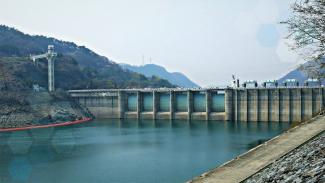Find it @ PPPLRC:
To find out more: Search the PPPLRC Library. Subscribe to the PPPLRC Newsletter. Contact us.
To find out more: Search the PPPLRC Library. Subscribe to the PPPLRC Newsletter. Contact us.
Find a collection of terms, references, instructions and notes to help in using the Climate Toolkit.
What they are - The present high-level toolkit outlines a framework and describes specific actions to support emerging market and developing economy (EMDE) governments, development partners (multilateral development banks (MDBs) and development finance institutions (DFIs)), and other stakeholders working on advisory services in incorporating climate actions in the up- and mid-stream phases of PPI projects. The toolkit is accompanied by a set of sector-specific toolkits providing specific instructions on "how" to implement the actions described in the present high-level document in specific infrastructure sectors.
Who can use them - The toolkits are meant to be used by government officials, PPP practitioners in MDBs and project sponsors in the preparation stages of PPI infrastructure projects. They are also meant to assist advisors by defining a concrete framework to outline the steps to incorporate climate considerations in their services. As the toolkits cover the entire PPP process, each one of them is not intended to be used by the same person in its entirety. Users could instead benefit from one or more relevant sections of the toolkits depending on their background, the nature of the project, and the phase of project implementation within the PPP cycle. Entry points to the toolkits are discussed below.
High-level toolkit: what and why - The toolkit is structured in phases, following the traditional phases of the PPP preparation cycle. Each phase includes modules of varying degrees of detail describing the actions foreseen to incorporate climate considerations in PPPs properly. In that sense, the high-level toolkit is to be treated as the reference document providing guidance on what should be done at each step and why it should be done. This is complemented by links to relevant tools and online resources and further reading recommendations to reinforce users' understanding. Phases and modules have been structured to be self-standing, allowing users to browse them independently.
Sector-specific toolkits: how - Following the logical order described in the high-level toolkit, the sector-specific toolkits intend to provide actionable instructions on how to implement each principle, taking account of the different nature of each sector/subsector and the different approaches, tools, and methodologies that are relevant to it. In this context, sector-specific toolkits contain two main parts. The first part covers in a practical way the Phase 1 of the PPP cycle, including simplified versions of tools that PPP units may use to perform initial assessments in-house. The second defines minimum requirements and qualifications that the PPP unit will have to request from consulting services to properly incorporate and evaluate climate adaptation, mitigation, and resilience characteristics in projects.
High-level toolkit navigator - As described above, the high-level toolkit is a reference document. Hence, it is recommended that users take advantage of the toolkit navigator/executive summary, which is intended to be used as an index allowing easy access to the proper module depending on the user's needs. The navigator is itself structured in phases, which are further broken down into modules and steps. It contains brief descriptions of each process's scope, contents, and intended outcomes, thereby offering a preview of the different parts of the toolkit and allowing users to immediately jump to the section(s) most relevant to their need(s) using hyperlinks.
Sector-specific toolkits - Sector-specific toolkits are separate documents that have the form of step-by-step instructions, frequently referring to specific parts of the present high-level toolkit. These toolkits provide detailed guidance for the entire up- and mid-stream stages of the PPP process through actionable items that are relevant to and applicable in specific infrastructure sectors. Their scope is to support PPP units performing specific actions during the very early (upstream) steps of the process and propose climate-related provisions to be included in the terms of reference (ToRs) for advisory services.


